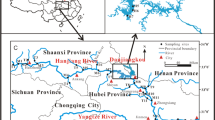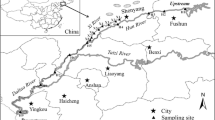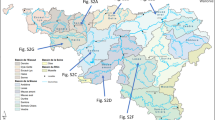Abstract
This study evaluated the occurrence, distribution and risk assessment of nine estrogenic compounds found in 29 source water sites in Ningbo City, China. They included 21 reservoirs, five river sites and three wells. The nine estrogenic compounds included estrone (E1), 4-n-nonylphenol (NP), 17α-ethynylestradiol (EE2), diethylstilbestrol (DES), estriol (E3), 17β-estradiol (E2), 4-t-octylphenol (OP), 17β-estradiol-17-valerate (EV), and bisphenol A (BPA). Generally, most of these estrogenic compounds were not detected in samples. Among estrogens detected, we found high concentrations of BPA up to μg/L levels while NP had the highest detection frequency of all estrogens in all samples. Samples taken from rivers had a higher detection frequency of estrogenic compounds than samples taken from reservoirs and wells. According to risk quotient (RQ) calculations for aquatic organisms living in source water contaminated by estrogenic compounds, the Fenghua and Yao rivers were at high risk. Results from this study can provide insight into selecting appropriate source water based on the accurate identification of compound and/or element contamination through the coupled analysis of their distribution and risk assessment.


Similar content being viewed by others
References
Belfroid A, Van der Horst A, Vethaak A, Schäfer A, Rijs G, Wegener J, Cofino W (1999) Analysis and occurrence of estrogenic hormones and their glucuronides in surface water and waste water in The Netherlands. Sci Total Environ 225:101–108
Caldwell DJ, Mastrocco F, Anderson PD, Länge R, Sumpter JP (2012) Predicted-no-effect concentrations for the steroid estrogens estrone, 17β-estradiol, estriol, and 17α-ethinylestradiol. Environ Toxicol Chem 31:1396–1406. doi:10.1002/etc.1825
Colborn T, vom Saal FS, Soto AM (1993) Developmental effects of endocrine-disrupting chemicals in wildlife and humans. Environ Health Perspect 101:378
Garnier-Laplace J, Della-Vedova C, Gilbin R, Copplestone D, Hingston J, Ciffroy P (2006) First derivation of predicted-no-effect values for freshwater and terrestrial ecosystems exposed to radioactive substances. Environ Sci Technol 40:6498–6505
Giger W, Brunner PH, Schaffner C (1984) 4-Nonylphenol in sewage-sludge—accumulation of toxic metabolites from nonionic surfactants. Science 225:623–625. doi:10.1126/science.6740328
Greenberg E et al (1984) Breast cancer in mothers given diethylstilbestrol in pregnancy. N Engl J Med 311:1393–1398
Gutendorf B, Westendorf J (2001) Comparison of an array of in vitro assays for the assessment of the estrogenic potential of natural and synthetic estrogens, phytoestrogens and xenoestrogens. Toxicology 166:79–89. doi:10.1016/S0300-483x(01)00437-1
Hernando M, Mezcua M, Fernandezalba A, Barcelo D (2006) Environmental risk assessment of pharmaceutical residues in wastewater effluents, surface waters and sediments. Talanta 69:334–342. doi:10.1016/j.talanta.2005.09.037
Hoover RN et al (2011) Adverse health outcomes in women exposed in utero to diethylstilbestrol. N Engl J Med 365:1304–1314
Isobe T, Shiraishi H, Yasuda M, Shinoda A, Suzuki H, Morita M (2003) Determination of estrogens and their conjugates in water using solid-phase extraction followed by liquid chromatography–tandem mass spectrometry. J Chromatogr A 984:195–202
Jiang W, Yan Y, Ma M, Wang D, Luo Q, Wang Z, Satyanarayanan SK (2012) Assessment of source water contamination by estrogenic disrupting compounds in China. J Environ Sci Chin 24:320–328. doi:10.1016/s1001-0742(11)60746-8
Jin X, Jiang G, Huang G, Liu J, Zhou Q (2004) Determination of 4-tert-octylphenol, 4-nonylphenol and bisphenol A in surface waters from the Haihe River in Tianjin by gas chromatography–mass spectrometry with selected ion monitoring. Chemosphere 56:1113–1119. doi:10.1016/j.chemosphere.2004.04.052
Jobling S, Nolan M, Tyler CR, Brighty G, Sumpter JP (1998) Widespread sexual disruption in wild fish. Environ Sci Technol 32:2498–2506. doi:10.1021/Es9710870
Jobling S et al (2006) Predicted exposures to steroid estrogens in UK rivers correlate with widespread sexual disruption in wild fish populations. Environ Health Perspect 114:32–39
Kang J-H, Kondo F, Katayama Y (2006) Human exposure to bisphenol A. Toxicology 226:79–89. doi:10.1016/j.tox.2006.06.009
Kawaguchi M et al (2004) Stir bar sorptive extraction with in situ derivatization and thermal desorption–gas chromatography–mass spectrometry in the multi-shot mode for determination of estrogens in river water samples. J Chromatogr A 1049:1–8. doi:10.1016/j.chroma.2004.08.013
Kim SD, Cho J, Kim IS, Vanderford BJ, Snyder SA (2007) Occurrence and removal of pharmaceuticals and endocrine disruptors in South Korean surface, drinking, and waste waters. Water Res 41:1013–1021. doi:10.1016/j.watres.2006.06.034
Komesli OT, Bakırdere S, Bayören C, Gökçay CF (2011) Simultaneous determination of selected endocrine disrupter compounds in wastewater samples in ultra trace levels using HPLC–ES–MS/MS. Environ Monit Assess 184:5215–5224. doi:10.1007/s10661-011-2334-x
Körner W, Bolz U, Süßmuth W, Hiller G, Schuller W, Hanf V, Hagenmaier H (2000) Input/output balance of estrogenic active compounds in a major municipal sewage plant in Germany. Chemosphere 40:1131–1142
Kumar V, Nakada N, Yasojima M, Yamashita N, Johnson AC, Tanaka H (2009) Rapid determination of free and conjugated estrogen in different water matrices by liquid chromatography–tandem mass spectrometry. Chemosphere 77:1440–1446. doi:10.1016/j.chemosphere.2009.08.052
Kuster M, Azevedo DA, López de Alda MJ, Aquino Neto FR, Barceló D (2009) Analysis of phytoestrogens, progestogens and estrogens in environmental waters from Rio de Janeiro (Brazil). Environ Int 35:997–1003. doi:10.1016/j.envint.2009.04.006
Labadie P, Hill EM (2007) Analysis of estrogens in river sediments by liquid chromatography–electrospray ionisation mass spectrometry. J Chromatogr A 1141:174–181. doi:10.1016/j.chroma.2006.12.045
Laganà A, Bacaloni A, De Leva I, Faberi A, Fago G, Marino A (2004) Analytical methodologies for determining the occurrence of endocrine disrupting chemicals in sewage treatment plants and natural waters. Anal Chim Acta 501:79–88. doi:10.1016/j.aca.2003.09.020
Lei B, Huang S, Zhou Y, Wang D, Wang Z (2009) Levels of six estrogens in water and sediment from three rivers in Tianjin area. China Chemosphere 76:36–42. doi:10.1016/j.chemosphere.2009.02.035
Li X, Ying G-G, Su H-C, Yang X-B, Wang L (2010) Simultaneous determination and assessment of 4-nonylphenol, bisphenol A and triclosan in tap water, bottled water and baby bottles. Environ Int 36:557–562. doi:10.1016/j.envint.2010.04.009
Nie M, Yang Y, Liu M, Yan C, Shi H, Dong W, Zhou JL (2014) Environmental estrogens in a drinking water reservoir area in Shanghai: occurrence, colloidal contribution and risk assessment. Sci Total Environ 487:785–791. doi:10.1016/j.scitotenv.2013.12.010
Noppe H et al (2007) Occurrence of estrogens in the Scheldt estuary: a 2-year survey. Ecotoxicol Environ Saf 66:1–8. doi:10.1016/j.ecoenv.2006.04.005
Peng X, Yu Y, Tang C, Tan J, Huang Q, Wang Z (2008) Occurrence of steroid estrogens, endocrine-disrupting phenols, and acid pharmaceutical residues in urban riverine water of the Pearl River Delta. South China Sci Total Environ 397:158–166. doi:10.1016/j.scitotenv.2008.02.059
Penning TM, Lee S-H, Jin Y, Gutierrez A, Blair IA (2010) Liquid chromatography–mass spectrometry (LC–MS) of steroid hormone metabolites and its applications. J Steroid Biochem Mol Biol 121:546–555. doi:10.1016/j.jsbmb.2010.01.005
Pojana G, Gomiero A, Jonkers N, Marcomini A (2007) Natural and synthetic endocrine disrupting compounds (EDCs) in water, sediment and biota of a coastal lagoon. Environ Int 33:929–936. doi:10.1016/j.envint.2007.05.003
Purdom C, Hardiman P, Bye V, Eno N, Tyler C, Sumpter J (1994) Estrogenic effects of effluents from sewage treatment works. Chem Ecol 8:275–285
Qi P, Wang Y, Mu J, Wang J (2011) Aquatic predicted no-effect-concentration derivation for perfluorooctane sulfonic acid. Environ Toxicol Chem 30:836–842. doi:10.1002/etc.460
Santhi VA, Sakai N, Ahmad ED, Mustafa AM (2012) Occurrence of bisphenol A in surface water, drinking water and plasma from Malaysia with exposure assessment from consumption of drinking water. Sci Total Environ 427–428:332–338. doi:10.1016/j.scitotenv.2012.04.041
Santos JL, Aparicio I, Alonso E (2007) Occurrence and risk assessment of pharmaceutically active compounds in wastewater treatment plants. A case study: Seville city (Spain). Environ Int 33:596–601. doi:10.1016/j.envint.2006.09.014
Smolders E, Oorts K, Van Sprang P, Schoeters I, Janssen CR, McGrath SP, McLaughlin MJ (2009) Toxicity of trace metals in soil as affected by soil type and aging after contamination: using calibrated bioavailability models to set ecological soil standards. Environ Toxicol Chem 28:1633–1642
Soares A, Guieysse B, Jefferson B, Cartmell E, Lester JN (2008) Nonylphenol in the environment: a critical review on occurrence, fate, toxicity and treatment in wastewaters. Environ Int 34:1033–1049. doi:10.1016/j.envint.2008.01.004
Staples CA, Dorn PB, Klecka GM, O’Block ST, Harris LR (1998) A review of the environmental fate, effects, and exposures of bisphenol A. Chemosphere 36:2149–2173. doi:10.1016/S0045-6535(97)10133-3
Staples CA, Dorn PB, Klecka GM, O’Block ST, Branson DR, Harris LR (2000) Bisphenol a concentrations in receiving waters near US manufacturing and processing facilities. Chemosphere 40:521–525
Tao X, Tang C, Wu P, Han Z, Zhang C, Zhang Y (2011) Occurrence and behaviour of nonylphenol and octylphenol in Nanming River, Guiyang City. China J Environ Monit 13:3269. doi:10.1039/c1em10471c
Vanderford BJ, Pearson RA, Rexing DJ, Snyder SA (2003) Analysis of endocrine disruptors, pharmaceuticals, and personal care products in water using liquid chromatography/tandem mass spectrometry. Anal Chem 75:6265–6274
Vega-Morales T, Sosa-Ferrera Z, Santana-Rodríguez JJ (2010) Determination of alkylphenol polyethoxylates, bisphenol-A, 17α-ethynylestradiol and 17β-estradiol and its metabolites in sewage samples by SPE and LC/MS/MS. J Hazard Mater 183:701–711. doi:10.1016/j.jhazmat.2010.07.083
Yamamoto A, Kakutani N, Yamamoto K, Kamiura T, Miyakoda H (2006) Steroid hormone profiles of urban and tidal rivers using LC/MS/MS equipped with electrospray ionization and atmospheric pressure photoionization sources. Environ Sci Technol 40:4132–4137
Young WF, Whitehouse P, Johnson I, Britain G (2002) Proposed predicted-no-effect-concentrations (PNECs) for natural and synthetic steroid oestrogens in surface waters. R&D Technical Report P2-TO4/1. Environment Agency, Bristol
Zhang X, Gao Y, Li Q, Li G, Guo Q, Yan C (2010) Estrogenic compounds and estrogenicity in surface water, sediments, and organisms from Yundang Lagoon in Xiamen, China. Arch Environ Contam Toxicol 61:93–100. doi:10.1007/s00244-010-9588-0
Zhao YW, Yang ZF (2009) Integrative fuzzy hierarchical model for river health assessment: a case study of Yong River in Ningbo City. Chin Commun Nonlinear Sci Numer Sim 14:1729–1736. doi:10.1016/j.cnsns.2007.09.019
Zhao J-L et al (2011) Estrogenic activity profiles and risks in surface waters and sediments of the Pearl River system in South China assessed by chemical analysis and in vitro bioassay. J Environ Monit 13:813. doi:10.1039/c0em00473a
Acknowledgments
We would like to thank anonymous reviewers for their helpful comments. In addition, we would like to thank the students from Minnan Normal University and Wuyi University who participated in water sample collection. We also gratefully acknowledge the joint research funding we received from the National Natural Science Foundation of China (41271484) and the Natural Science Foundation of Fujian Province (2013J01166) as well as from the Institute of Urban Environment, Chinese Academy of Sciences for Young Scientists in Frontier Research (IUEQN-2012-04). We also thank Brian Doonan for help in polishing this manuscript.
Author information
Authors and Affiliations
Corresponding authors
Electronic supplementary material
Below is the link to the electronic supplementary material.
Rights and permissions
About this article
Cite this article
Wang, D., Luo, Z., Zhang, X. et al. Occurrence, distribution and risk assessment of estrogenic compounds for three source water types in Ningbo City, China. Environ Earth Sci 74, 5961–5969 (2015). https://doi.org/10.1007/s12665-015-4619-9
Received:
Accepted:
Published:
Issue Date:
DOI: https://doi.org/10.1007/s12665-015-4619-9




